|
|
|
|
|
|
|
|
|
|
|
 |
|
 |
|
|
Pohnpei State, FSM - November to December 1998
|
|
|
|
|
 |
|
|
|
|
|
|
Winding Down
|
|
|
|
|
November 11, 1998
I have a gecko friend now, too. It hangs out on our table in the kitchen, and just runs around and explores. It runs in and out of our papers, and just all over the place. Sometimes it just sits on the edge of the table and watches us. I guess that is about the closest we will come to having a pet.
It's funny, I feel like I can't really teach Retty anything, because he is a very bright and intelligent guy who has the history of this place at his fingertips. Utterly mind-boggling if you ask me. Yet, at the same time, I am introducing him to some of the more technical things, aspects of archaeology, like how to triangulate your position with a compass.
Retty and I talked a bit more about oral history here. There used to be a society of historians here, although that was not what it was called. The last time they met was about the turn of the century, and their meeting was about the coming century and the changes that would occur with the introduction of apparatus, the influx of new people from other places, and the disruption that would cause overall to the society at hand. They apparently decided to deliberately disrupt some of the old histories and stories --- so that others who had no repsect for such things would not have them. They went about and took stones of importance, and other objects, and placed them in other unknown places. In that way, they "hid" these stories and histories --- they essentially took the object out of its context, thereby introducing disruption to the story cycle. Others deliberately inserted stories into stories to disrupt the flow of the original stories.
November 14, 1998
Teresa and her friend Junior (his father is Captain of the Micro Glory, the ship that took relatives to Pingelap for the celebration) have a sort of cute communication mode --- they whistle to one another. Last night, about 9 or so, we went out onto the porch and looked at stars, smelled the air (full of flowers --- flowers seem to release their smells at night, after the heat of the day has disappeared) --- when we heard a little whistle. It was Junior, on his porch (the house next door to the apartment building). So, Teresa whistled back. If was almost a gentle form of communication --- little whistles back and forth.
November 15, 1998
I am almost finished with the legislation, which is turning out to be a nice piece of work. I don't know if it can all work, or if the parts will fit with one another, but I at least have all the parts I want to put into it. If nothing else, there is enough stuff there for any legislator to play with.
November 18, 1998
Well, I saved a little bit of Nan Madol today. It seems that a Japanese company wanted to remove two columnar basalt stones from Nan Madol to take back to Japan for incorporation into a monument to the Mu Continent. They have been gathering stones from Kiribasi (the Gilberts) and Tarawa, and will go to Easter Island next. These are "cultural materials" of course and cannot be removed. I also discovered that the Nahnmwarki was never consulted --- the site is extraordinarily important to Pohnpei and the municipality, and yet, no consultations with the traditional leader. So, I went out there (with Rosenda as my guide and interpreter) and looked at what the Japanese group wanted to take --- the only columnar basalt there is part of a tomb, albeit a tomb located on privately owned land. Nan Madol is a huge complex, part in the lagoon, but it also extends onto the island it is connected to. I proposed that the Japanese group go instead to one of the geological sources for the stone.
November 19, 1998
The representative of the Japanese group showed up this morning. He had managed to track down Retty and agreed last night to meet him this morning because he had understood that as rocks from Nan Madol were off-limits, he would try one of the places I suggested --- in this case, Pwusin Malik (literally "chicken-shit rock"), which is one giant columnar basalt deposit. So, Retty, me and the Japanese gentleman go off to find the owner of Pwusin Malik. The man isn't too sure about letting the Japanese group have rocks --- I don't understand Pohnpeian, but I can understand Retty's face and his tone of voice. Finally the land owner decides it's okay. He then takes us up to a rubble field on Pwusin Malik that has any number of pieces of columnar basalt strewn abut. Next comes the negotiation of price --- how much for the stone? The landowner is a wise fellow, so, he asks the Japanese fellow (through Retty because he does not speak English) what he thinks a fair price would be. My immediate reaction was to laugh; I couldn't help it. The guy ended up receiving $200 for the bunch.
Then it was time to go to the Section Chief (each municipality is divided into sections, each of which is overseen by a Section Chief) to get his permission and blessing, as it were. This is also the guy who would have to be consulted because he holds the power of the spirits of that section, and if he is appeased, so are the spirits. Retty negotiates for the Japanese fellow to have the section chief conduct a special sakau ceremony and to provide the guys to take the rocks off the mountain. All that is accomplished by noon. The Japanese fellow is happy; he has his stones, which look exactly like the ones on Nan Madol, and the tomb site at Nan Madol keeps its integrity.
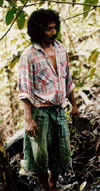 |
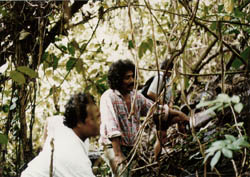 |
|
John Soukon, land owner who gave permission to the Japanese group to remove basalt columns.
|
Retty Lawrence and John Soukon
examine basalt columns.
|
Note: my legislation was a big hit. I'm pleased. Now it's a matter of someone introducing it as a bill in the state legislature. This should offer some further protections to cultural sites, Nan Madol included.
Retty showed up later in the office with a container of black sand. There are only two places here with black sand, and one of them is virtually gone now. He wanted to know why the sand was black. That was his question, but only after he put me through a little test --- tell him what was in the jar. So I smelled it (it smelled of earth, and rock), and tasted it. (He was taken aback by that --- what are you doing? why are you putting it in your mouth? he asked --- but its grittiness told me it was rock too, and so fine that it had to be sand, or some really pulverized rock.) Then I said it was basalt. But why, he asked. How did this basalt become sand? I tried to describe the process of basalt formation, where this particular deposit was likely to be, how water action essentially made it what it is in the jar --- sand. White sand is coral limestone pounded to smithereens, which means the black sand is rock (basalt) pounded to smithereens. Turns out, this black sand deposit is right where two currents meet in powerful collisions. Aha! I said, there is the action. As for the stone itself --- it may be gone now, or buried. But it was definitely volcanic, definitely a basalt. That must have been reasonable. He said he never told anyone about this sand, only me. And it was a personal gift from him to me. I was touched.
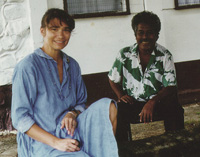 November 20, 1998 November 20, 1998
I love the surveyors. They are real professionals, and they can be a real kick in the pants when you catch them in the right mood. Teresa hangs out with them, and they put her to work "to be on the lookout for bugs" that might get on their transits. This is a photo of me and Masuo Edward. Masuo is one of the surveyors in the Pohnpei State Division of Lands office.
November 21, 1998
The Book of Luelen, by Luelen Bernart, translated and edited by John L. Fischer, Saul H. Riesenberg, and Marjorie G. Whiting. Published by Australian National University Press, Canberra, 1977 --- I actually got about halfway through it today at the Micronesian Seminar. Fran Hezel (who is always there anyway) let me use the library. The Book of Luelen is loaded with all kinds of stories on the history of Pohnpei, as documented through oral histories. It is very interesting. Pohnpei means "on a stone platform". The word pei is "stone platform", pohn is "on" or "on top of". According to the story, a long time ago, some guys loaded up in a canoe and set sail. They knew that if they were to travel far enough they would find land; they had to get past the point where the sky meets the sea, because after that, there was land. On their voyage they met an octopus who told them he lived on the giant reef which ran east to west and went far into the depths of the ocean. They took their leave of the octopus and soon came to the reef that was the octopus's home. They decided to land here. There was just enough land on the reef to span their canoe, to reach from the outrigger to the boat. So they decided to make the land bigger, and called rocks and corals from many places by magic to add to their land. Then they began to pile soil on top of this rock platform (hence the name of the place --- pohnpei --- on top of a stone platform). The story continues with people coming and going, with the island growing as people extend it and put more soil on it, until it becomes a very big place. Then the vegetation starts to grow, and food plants. It is interesting how the story just continues to build from that beginning of a small place on the reef. People start to make clothes, someone introduces fire so they can cook their food now, the language becomes its own unique form, and on and on. I read ahead a little and noticed that Kosrae figures into the oral histories --- there really must have been some back and forth movement. In one story, Kosrae contributed to the building of a platform. I have to get a copy of this book.
November 22, 1998
Finally had a chance to relax. Teresa, me, Jane Barnwell (my old friend, the librarian from Palau, who is passing through on her way from a conference), Grace (her assistant), and Jane's friend Sue (she is a court reporter, freelance, who works for lawyers and others) went to Lenger Island to swim, let Jane and Grace try sakau, and generally catch up on the gossip from Palau. Lenger Island is quite beautiful, and the chief quite gracious.
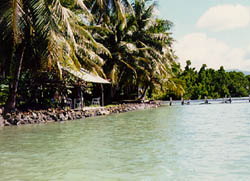 |
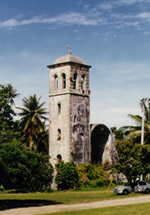 |
|
Lenger Island
|
Remains of German tower
|
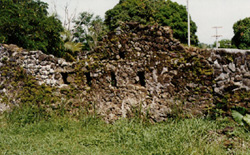 |
Remains of Spanish wall, front view |
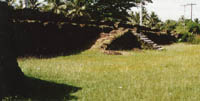 |
Remains of Spanish wall, back view |
November 23, 1998
I spent the entire day in the surveyor's office. I got some scanned image files transferred from their PC to my Mac. I was able to do some joining in Photoshop and even started some clean-up work on them. And, what is more, I was able to create a project file in ArcView with seperate views for each of the images. Now I can really spend some time with them and learn the ins and outs and also create (I hope) something for ESRI.
November 24, 1998
ArcView is installed on the PowerMac 7500 we gave to the federal office. I hope to mess around with it a little tomorrow, throw in the copy of the ArcView project I made yesterday. I really want to get at least one nice map out of this before leaving for Yap.
I asked Retty last week to take me to sites (I was thinking of architecture and the stuff I like). He said, What do you mean, we have been going to lots of sites! Well, that is of course true. We have been going to sites that have played a role in the history of Pohnpei, especially the oral history. I am getting a couple of rolls of film developed that have some of the pictures of these on them. I also got the stories down from Retty. There are plenty more in Luelen.
This morning Roster gave me a mwaramwar from Mwoakilloa (her place --- an atoll between Pohnpei and Pingelap). It is made of shells, and is quite beautiful. I was so touched.
November 25, 1998
Today I read over the special project proposals for Kosrae and Yap --- very interesting stuff. Interestingly, both Kosrae and Yap point to WWII as a part of their historic-sites base and a part of their history that is important in the development of themselves. Pohnpei has until very recently viewed WWII as a virtual non-event, more meaningful for foreigners than themselves. Unfortunately, they were a very integral part of it too.
November 26, 1998
I got a map of Pohnpei from the Surveyors today. It is in two parts and huge files. These images are scans of the USGS map of Pohnpei proper --- it doesn't even include the outer islands. Anyway, I'm finding that GIS is no mystery at all --- it is just another application for maps and information about stuff on maps, simply a set of mechanics that requires technician-level work for the most part. Of course, it is hard learning the mechanics. Once that is done, all you need is some imagination and a bit of organization in your head to pull together a meaningful map. In a way, it is like a database or statistics or something --- your selection of information is inevitably made with certain ideas in mind, and you can demonstrate darn near anything.
November 28, 1998
Today we went to the beach, upon the invitation of Mr. Kim. He was throwing a party for his crews and we were invited. Teresa enjoyed it. Most of the crews know me from Palau; now they know Teresa. One fellow is married and has his wife and child with them --- so Teresa had a playmate. Mrs. Kim was also doting on the two girls --- she is funny; can't speak a word of English, but you know what she is saying anyway! And always laughing. Teresa really likes her.
November 30, 1998
I spent the day in the surveyor's office. I am gaining a better understanding of ArcView and GIS as a whole --- they consist of databases which are linked to maps. And as such, they become powerful query tools --- every time a database changes, the map changes. How that will mesh with archaeological data, I am not sure at the moment, but it has potential for site distribution studies, keying certain site types into a database for an overall map of sites and a look-see of various site types. Perhaps looking at which sites always seem to cluster together or some such thing. I was talking with Kondias, head of the survey office (he finally got back from a long tour of the U.S., with lots of training). We were talking about GIS, and he, like me, agreed that it would only work if you had good coordinates for site locations, not wishy-washy vague approximations! I like Kondias a lot!! And, what a big difference in taking on trainings --- he could hardly wait to start implementing some of the things he had learned, and was excitedly talking about everything he did and saw.
We have Yap to start moving toward. I have already talked to the post office about mailing rates --- I can send things to "General Delivery: Hold Until Arrival."
December 1, 1998
I have yet to return to the Micronesian Seminar to finish the Luelen book. I didn't get to the story about the stone-setters yet. Like most places out here, you expect a history of clan warfare and competition. That is the norm. The oral histories of Palau are filled with such things --- with shifting alliances, betrayals, intrigue, you name it, it's there. The Pohnpeian stories are more fantastic to me. They are filled with nature spirits, a lot of magic, little people, underworld places, and so on. Palau's are loaded with politics more than anything else.
Yap and Kosrae sound like interesting places. Both very different from one another. I am actually looking forward to those places. Now, it is simply a matter of setting up the logistics to get there.
December 2, 1998
No field, even though it is Wednesday. I had gone into that office to drop off a couple of things for Retty --- namely step by step instructions on use of a transit, reading stadio and elevations, and that sort of thing. Retty was rushing off to talk to an old man who had called him, however. He was ready to talk. And probably ready to die --- that is frequently the case when someone is feeling close to the end. They call upon their entrusted ear to release all their information so it gets carried on into the next generation.
I think it is interesting that kids kind of have the run of this place --- they are doted upon, watched over, given a lot of leeway, and just left to run hither and yon. Compare that to places in the U.S., where kids are treated as a nuisance, to be sheltered and hidden, and generally kept out of sight. Most people get a kick out of Teresa; the surveyors tease her, chat with her, and generally keep an eye on her. The lady at the post office makes sure Teresa tells her our box number when we go pick up packages; little old ladies pat her on the back in the street and say what a good baby. Even Mrs. Kim looks after her when she is out playing with her buddies at the apartment. Mr. Kim and his crews will shout good morning as we walk past on our way to school; they also tell her to do well in school, etc. (With Mr. Cha, we always have to bow --- it's what they do in Korea, besides being happy guys like Mr. and Mrs. Kim, according to Teresa.)
December 3, 1998
Just talked with Rufino --- giving him updates on what I have been doing, he giving me updates on what he has been doing. I told him about ArcView, and our success of yesterday with the surveyors, about my thoughts of reprogramming some of the money for Pohnpei State into a project for Retty and the surveyors (getting GPS satellite coordinates for various sites around the island) so they can tie their historic sites into the GIS system, and my next step with ArcView --- creating a table in FileMaker with a couple of coordinates, importing it to ArcView and seeing what happens.
December 4, 1998
Teresa found part of a dog skull --- she said, oh, poor dog. What I didn't tell her was that poor dog was eaten --- it was divided up and eaten. The part of the skull she had found had the nose chopped off, and was simply half a skull with saw marks prominent on all edges. Well, actually, they are machete marks.
December 8, 1998
A fellow was murdered and found under a little bridge at a bar (a bar in the mangroves; you have to walk over a small bridge to get to it). The guy was from a rough family with lots of younger guys that get wild and crazy when they get drunk. The interesting thing about it all --- he was killed by another cousin. Now, what happens in traditional culture is that the killer's family approaches the victim's family and asks for forgiveness. It takes place over sakau. Most of the time these apologies are accepted, although one never can be quite sure. There have been other times when the victim's family has descended on the killer and killed him. It isn't the usual thing to happen, but the prospects for it happening are always there. If an apology is accepted, the killer is customarily given over to the victim's family and essentially replaces the victim --- as a brother, working for the family, and so on. Not as a slave, but as a member of the family. It is a system that apparently works rather well here. The system of Western jurisprudence has interrupted this cycle somewhat, and it has lessened the meaning of apologies, as most every one knows the killer will have to stand trial anyway. But, in the courts, the apologies are always brought into evidence.
We are supposed to make the move the last week of December --- right now, we are shooting for the 28th (a Tuesday). I don't know yet about reservations.
December 12, 1998
Today seems to be going unbelievably slow. I have been working on my summary of work at Pohnpei.
We just got back from the German belltower --- they had their lighting up of a nativity scene. My whole objective in going there tonight was as a diversion for Teresa. And it worked. It turned out to be rather fun. The nativity scene is in the apse of the belltower, and consists of some painted boards of the principals of that scene, but then it begins to deviate. There are palm fronds set up along the walls and at the roof of the stable and lots of papier-mâché animals. Big ones too --- a giraffe, a camel, a zebra (on our walk today, we had seen a zebra in the back of a pick-up; now we know where it went), a bull, a sheep with cotton balls for hair, a panda bear, fish hanging from above, three-dimensional stars, a fruit bat. It is very interesting. Then, and most important for the child, Christmas lights swirling up the palm tree beside the apse, on the ceiling of the apse, and on the belltower itself. Walking home, I looked at my watch and noted that it was after nine. Teresa reminded me that we better hurry home and be quiet too because it was time for the ghost to come out.
December 13, 1998
I met Berlin Sigrah, the HPO for Kosrae --- he is a very nice man, and has a program that actually sounds like it is intact, functioning, and probably the model for the FSM --- that is, if more people knew about it! The archaeology of Kosrae sounds incredible too. A bit of work has been done in the upland areas, but little or no work on the coast. Sites are architectural --- walled villages with platforms and such throughout! I think Kosrae is one of the best-kept secrets in Pacific archaeology, or so it sounds from the descriptions. Pohnpei is a dispersed settlement; Kosrae is concentrated --- both have extensive stone architectural remains. Only it sounds as though Kosrae's may be rather more elaborate. Berlin has already been thinking about what I can do there --- say, excavations at some of the more significant sites. One, where the last king of Kosrae settled; another on the coast in a very traditional fishing community that you can only get to by boat; or another that is important in oral history and culturally, as it is the only place where the pigment for red paint comes from (prehistorically).
My work in Kosrae then, is mainly going to be excavations in significant sites, with the work used to train the HPO staff as well as members of the community. He has money to pay about 15 people from the community to participate. I am really curious just what is awaiting me in Yap. The potential for archaeology there is tremendous as well, and it should be much like Palau, as those two seemed to have an on-going interaction throughout their histories.
December 15, 1998
I had to go into the Pohnpei office to return the transit and tripod to the Survey office, where I ended up talking with Kondias, the man who heads that office. He is from Pingelap, and was probably more instrumental in accommodating us there than anyone else. So, he asked me about my report on Pingelap --- I thought I had given him a copy, but I made him another. Out of everyone, he is the only one who has expressed an interest in it! We talked a bit about Pingelap, and I told him about Jones and Berlin's conversation about a shallow place in the ocean between Kosrae and Pingelap, where fishermen who don't return are supposed to go. He laughed; he knew the story, and said there was a lot of interaction between Pingelap and Kosrae.
I said if we could swing it, we ought to get a big crew of us together --- me, Retty, Kondias, and a bunch of his guys --- and start right in on a thorough survey, archaeological and historical, of the atoll. Kondias and I also agreed that it was much nicer working on the older instruments too. We started chatting about those as I was returning the transit to its closet. You can get better and immediate readings from the newer instruments, but for teaching someone, there is nothing better than the old ones.
December 16, 1998
Roster just got a gold tooth (well, I guess it is just a thin covering) --- apparently, here it is a sign of status for a woman to have gold teeth. Roster says it is an investment, so that when you die, there is something immediate for your children (I can't imagine it being worth a whole lot, however). In fact, the wife of the former governor (I think) had all gold teeth in the front of her mouth --- when she went abroad just after having it done, she ended up getting very embarrassed because in the places she went, like the U.S., people just stared at her mouth every time she opened it. When she got home, she had her dentist make her a plate (or whatever it is) with white teeth, so she could wear it abroad. Men, however, do not get gold teeth. The only men with gold teeth are homosexuals, I'm told.
December 21, 1998
Just talked to Truman --- looks like we may actually be heading to Yap on Saturday.
December 22, 1998
Well, Rufino just called. We are going to delay until next week; he is going to check with the travel agent to see if we can't just go straight through Tuesday/Wednesday; otherwise it will be next Saturday.
December 25, 1998
Me, Teresa and Junior went to the movie theater that just opened here. Junior had never been to a movie theater before. He asked a lot of questions, like What is that box for? He was looking at the screen when we had gone in to sit down in the theater. When we looked up at the projection booth, he didn't know what the film was --- What is that purple line, he asked. Then he wanted to know why I had tickets, was it for a raffle? Stuff like that. Things you never really think about. It is still hard for him to grasp the idea that they show the same films over and over again on a set schedule. Junior's family is from Nukuoro, one of the Polynesian outliers here; like Kapingimarangi. It was funny trying to explain movies and movie theaters to him on the way to the theater --- he had in mind a large TV set where you watched videos, and proceeded to tell us how he watched the movie Zorro at his cousin's, and how he really liked the movie. So, he is a Zorro fan.
December 30, 1998
Finally, a firm departure schedule. We leave here Saturday afternoon to Guam, spend the night, then move on to Yap.
December 31, 1998
New Year's Eve was rather interesting. By 11 or 11:30 the streets were absolutely deserted. In fact you would have thought everyone had gone home and to bed. It was really quiet, except for the rain. Then about 12:30, up to about 6 this morning, the streets exploded with noise!! Cars honking, people yelling, makeshift parades of kids walking down the street banging on drums made out of large cracker tins, sirens, dogs barking, pans rattling. It was loud. Teresa slept through it all though. After 6 it started to get quiet again. People drooping homeward to sleep.
January 1, 1999
Next: Yap State
|
|
|
|